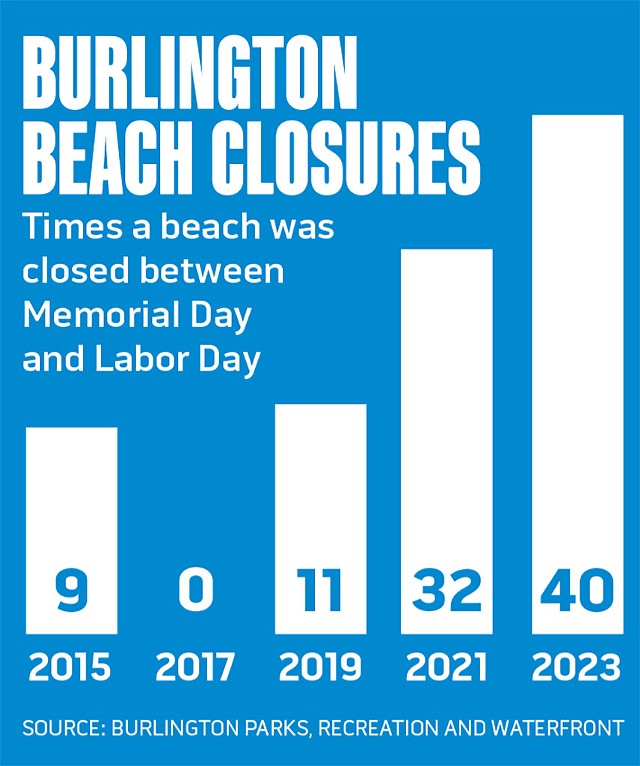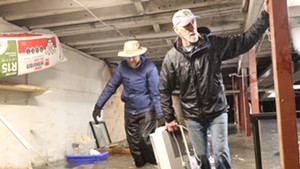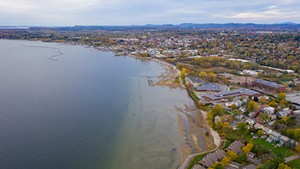
- Courtney Lamdin ©️ Seven Days
- Burlington beach manager Alec Kaeding looking for blue-green algae
Alec Kaeding motored his utility vehicle along the shoreline at Burlington's North Beach one afternoon last week, squinting through polarized sunglasses at the quietly lapping water.
Kaeding, the city's beach manager, was hunting for signs of cyanobacteria blooms, potentially toxic slicks of blue-green slime that can paint the near-shore water of Burlington Bay on summer days. On this day, a bright spot in an otherwise rainy week, the conditions were ripe for blooms — and for disappointment. Should cyanobacteria show up, Kaeding would have to tell everyone to get out of the water.
"It's always a day when everybody's here," he lamented, waving at kids splashing in the waves. "I feel horrible because I'm the beach manager: I want to see people at the beach and just enjoying themselves."
Kaeding has had to get used to delivering bad news. As of this week, Burlington's five beaches have been closed a combined 40 times this summer due to cyanobacteria blooms — 10 more than the entire 2022 season and four times the number back in 2019.
Cyanobacteria, also known as blue-green algae, are fed by an excess of the nutrient phosphorus that runs into waterways from roads and farmland. They flourish on hot, sunny days in calm lakes, ponds and shallow waters.
The bacteria sometimes contain toxins that can sicken people and animals. In 1999, a dog died after ingesting the algae in Lake Champlain, prompting Vermont to start tracking the blooms. At least two other dogs have since been poisoned by the bacteria.
Last month's flooding inundated Lake Champlain with a year's worth of phosphorus runoff. If temperatures stay warm, Burlington beachgoers may need to find other ways to cool down this summer.
"All the pieces are there for this to be a bad year for blooms and beach closures," said Oliver Pierson, lakes and ponds program manager at the Vermont Department of Environmental Conservation. "We're in a wait-and-see mode, but we're on edge."
Cyanobacteria blooms are a tricky adversary. They're shape-shifters, for one. The blue-green algae can first appear as tiny granules on the water's surface, then morph into a dense, paint-like sheen. And their spread is unpredictable: If one beach has a bloom, one a mile away may not.
The Vermont Department of Health publishes a cyanobacteria bloom tracker for water bodies around the state, updated with real-time reports from more than 100 volunteers, but it doesn't indicate whether a swimming spot is closed. Beachgoers have to consult individual town and city websites for that information, and some monitoring programs are more robust than others.

In Burlington, city workers inspect beaches several times a day and perform water tests when they spot a bloom. The state says the city must wait until the following day to test again to determine whether the blue-green scum is gone and the beach can reopen. Such caution is warranted: Touching toxic blooms or swallowing contaminated water can cause skin and throat irritation or vomiting. But because you can't tell whether a bloom is dangerous just by looking at it, the best and only option is to ban swimming until the algae goes away.
Burlingtonians have lost a lot of beach time as a result. By Seven Days' unscientific count, the Queen City has had about 45 good beach days, or those with no rain or just trace amounts, from Memorial Day through Tuesday. At least one beach was closed on nearly a quarter of those days, including a six-day stretch around the Fourth of July, when temperatures averaged 88 degrees.
Historic flooding came soon after. Rivers overflowed and washed a heavy load of nutrient-laden silt into Lake Champlain. A Burlington city sewer pipe in the Winooski River broke, too, spilling untreated sewage for several days. On the plus side: The sediment blocked the light that cyanobacteria need to grow. But the muddy reprieve didn't last long. On July 19, just over a week after the flood, an algae bloom closed Texaco Beach in the New North End. By the next day, the four remaining beaches had blooms.
Swimming spots elsewhere have arguably had it worse. For the past three weeks, beaches in St. Albans Bay have had blooms every day, according to reports from the nonprofit Lake Champlain Committee. Missisquoi Bay, which has shallower, more stagnant water than Burlington, has also been hit hard this year.
Pierson, the state lakes and ponds manager, said the trend will likely continue. Excess phosphorus is like an all-you-can-eat buffet for cyanobacteria, and, with waters now calmer, sunlight can penetrate and encourage the bacteria to multiply. Warm weather is also an accelerant, and summer isn't yet over in this year of record-breaking heat.
"If we get some hot, sunny days and soils can dry out and become less prone to flooding, that's our best-case scenario," Pierson said. "If that leads to better conditions for blooms, so be it."
Lori Fisher, executive director of the Lake Champlain Committee, worries that this year's perfect cyanobacteria storm will spill over into next season. Certain types of the bacteria can survive the winter by settling into the sediment, she said, and the colonies may reemerge in the calm, shallow waters of public beaches.
Fisher's organization is helping swimmers identify potential danger. Its website displays photos of blue-green algae blooms alongside pictures of similar-looking but harmless conditions, such as swaths of pollen on the water's surface or patches of duckweed, a buoyant aquatic plant. Fisher also encourages people to report suspected blooms and check the cyanobacteria tracker before going in the water. Her words to swim by? "When in doubt, stay out."
Back at North Beach last week, swimmers were all in. Satisfied they were safe, beach manager Kaeding finished his shoreline patrol and zipped up the Burlington bike path in his electric cart. In the cargo bed was a bright red sign proclaiming, in all caps, "Beach closed due to cyanobacteria."
On that particular day, Kaeding wouldn't have to use it. He pulled over at the city dog park and walked to the large granite steps that lead down to the lake — not a beach but a spot where canines and their people can take a quick dip.
The water was algae-free.
"Nice and clear," Kaeding said. "Just like we like it."













Comments
Comments are closed.
From 2014-2020, Seven Days allowed readers to comment on all stories posted on our website. While we've appreciated the suggestions and insights, right now Seven Days is prioritizing our core mission — producing high-quality, responsible local journalism — over moderating online debates between readers.
To criticize, correct or praise our reporting, please send us a letter to the editor or send us a tip. We’ll check it out and report the results.
Online comments may return when we have better tech tools for managing them. Thanks for reading.